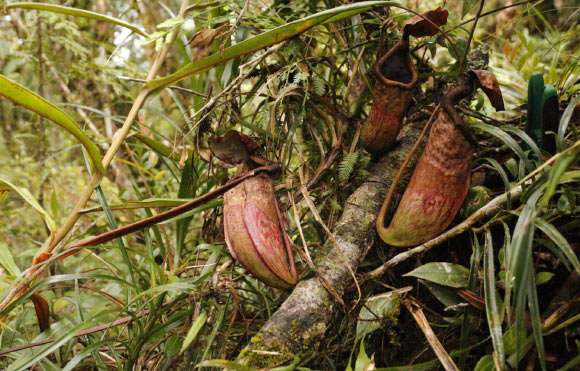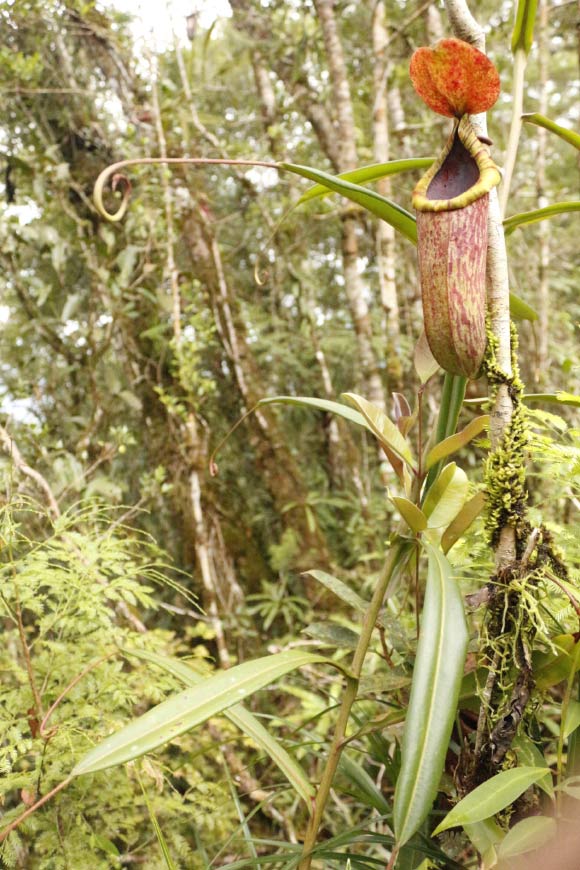A team of biologists from the Central Mindanao University has discovered a new endemic species of carnivorous plant in the montane tropical rainforests of Philippines.
The newly-discovered species belongs to Nepenthes, a genus of tropical pitcher plants in the monotypic family Nepenthaceae.
The genus comprises over 170 species, mostly native to Madagascar, Southeast Asia, and Australia. The greatest diversity occurs on Borneo, Sumatra, and the Philippines, with many endemic species.
Also known monkey cups (because monkeys have been observed drinking rainwater from these plants), all Nepenthes species are carnivorous plants that capture their prey by means of modified pitcher-shaped leaves that function as passive pitfall traps.
Attracted by nectar secreted from the underside of the trap’s lid, insects and other prey slip from the mouth of the pitcher into a pool of liquid and are unable to escape, because of the pitcher’s downward-pointing hairs and slick sides. The animals drown and are eventually digested by enzymes.
Named Nepenthes cabanae, the newfound species occurs only in Mt. Malimumu, Pantaron range, Bukidnon Province of Mindanao Island, Philippines.
“This discovery brings the number of Nepenthes species in this mountain range to eight,” said Central Mindanao University researchers Noel Lagunday and Victor Amoroso.
“Mt. Pantaron is currently not a protected area, but the diversity of Nepenthes suggests concerted efforts should be made to develop a conservation strategy to preserve and protect the area.”

Upper pitchers and leaf attachment on living plant of Nepenthes cabanae. Image credit: N.E. Lagunday.
Nepenthes cabanae has a climbing stem up to 8 m long and 6-8 mm in diameter; leaves are 26.3 to 34 cm long and 3.2 to 4.6 cm wide.
“Nepenthes cabanae populations were observed in the montane tropical rainforest, scrambling on understory plants and shrubs with clay substrate and less sunlight exposure,” the biologists said.
“Only about 10 individuals of Nepenthes cabanae around 10-25 m apart were recorded during sampling, these were observed along ridge trails connecting several Manobo tribe villages along the mountain range.”
Dr. Lagunday and Dr. Amoroso propose the IUCN conservation category ‘Critically Endangered’ for Nepenthes cabanae.
“With an estimated extent of occurrence of less than 10 km2, Nepenthes cabanae is likely to suffer habitat loss from quarrying, illegal logging, agriculture and slash and burn,” the scientists said.
“Mt. Pantaron is currently not a protected area, and the presence of threatened and endemic species of Nepenthes in the area calls for immediate conservation strategies by the local stakeholders to preserve and protect these plants from illegal poaching.”
A paper about the discovery of Nepenthes cabanae appears in the Philippine Journal of Systematic Biology.
_____
Noel E. Lagunday & Victor B. Amoroso. 2019. Nepenthes cabanae (Caryophyllales, Nepenthaceae), a new species of pitcher plant from Central Mindanao, Philippines. Philippine Journal of Systematic Biology 13 (1): 39-45; doi: 10.26757/pjsb2019a13005








